Georges Dumézil
Georges Edmond Raoul Dumézil (4 March 1898 – 11 October 1986) was a French philologist, linguist, and religious studies scholar who specialized in comparative linguistics and mythology. He was a professor at Istanbul University, École pratique des hautes études and the Collège de France, and a member of the Académie Française. Dumézil is well known for his formulation of the trifunctional hypothesis on Proto-Indo-European mythology and society. His research has had a major influence on the fields of comparative mythology and Indo-European studies.
Georges Dumézil | |
|---|---|
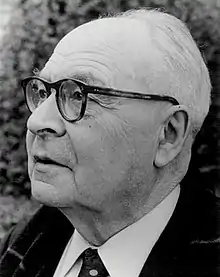 | |
| Born | 4 March 1898 Paris, France |
| Died | 11 October 1986 (aged 88) Paris, France |
| Nationality | French |
| Occupation | Philologist, linguist, religious studies scholar |
| Spouse | Madeleine Legrand (after 1925) |
| Children | 2 |
| Academic background | |
| Alma mater | |
| Thesis | Le festin d'immortalité (1924) |
| Doctoral advisor | Antoine Meillet |
| Other advisors | Michel Bréal |
| Influences |
|
| Academic work | |
| Discipline | |
| Sub-discipline |
|
| Institutions |
|
| Main interests | Proto-Indo-European mythology and society |
| Notable works | Mythe et epopee (1968–1973) |
| Notable ideas | Trifunctional hypothesis |
| Influenced |
|
Early life and education
Georges Dumézil was born in Paris, France, on 4 March 1898, the son of Jean Anatole Jean Dumézil and Marguerite Dutier. His father was a highly educated general in the French Army.[1]
Dumézil received an elite education in Paris at the Collège de Neufchâteau, Lycée de Troyes, Lycée Louis-le-Grand and Lycée de Tarbes.[1] He came to master Ancient Greek and Latin at an early age. Through the influence of Michel Bréal, who was a student of Franz Bopp and the grandfather of one of Dumézil's friends, Dumézil came to master Sanskrit, and developed a strong interest in Indo-European mythology and religion.[2] He began studying at École normale supérieure (ENS) in 1916.[1] During World War I, Dumézil served as an artillery officer in the French Army, for which he received the Croix de Guerre. His father was inspector-general of the French artillery corps during the war.[2]
Dumézil returned to his studies at ENS in 1919. His most important teacher there was Antoine Meillet, who gave him a rigorous introduction in Iranian and Indo-European linguistics.[2] Meillet was to have a great influence on Dumézil.[1] Unlike other students of Meillet, Dumézil was more interested in mythology than linguistics.[2] In the 19th century, philologists such as Franz Felix Adalbert Kuhn, Max Müller and Elard Hugo Meyer (who had influenced Bréal) had conducted notable work on comparative mythology, but their theories had since been found to be mostly untenable.[2][3] Dumézil became determined to restore the field of comparative mythology from its contemporary discredit.[2]
Dumézil lectured at Lycee de Beauvais in 1920, and taught French at the University of Warsaw in 1920–1921.[2] While lecturing at Warsaw, Dumézil was struck by striking similarities between Sanskrit literature and the works of Ovid, which suggested to him that these pieces of literature contained traces of a common Indo-European heritage.[4]
Dumézil gained his PhD in comparative religion in 1924 with the thesis Le festin d'immortalité. Inspired by the works of Ernst Kuhn, the thesis examined ritual drinks in Indo-Iranian, Germanic, Celtic, Slavic and Italic religion. Dumézil's early writings were also inspired by the research of James George Frazer, whose views were however becoming discredited due to advances in the field of anthropology. At ENS, Dumézil became a close friend of Pierre Gaxotte. Gaxotte was a follower of Charles Maurras, leader of the nationalist Action Française movement.[2][5] Though some have accused Dumézil of being in sympathy with Action Française, this has been denied by Dumézil, who was never a member of the organization.[6]
Dumézil's PhD thesis was highly praised by Meillet, who requested Marcel Mauss and Henri Hubert, both followers of Émile Durkheim, to assist Dumézil with further studies. For reasons unknown, the request was turned down. Mauss and Hubert were both socialists in the spirit of Jean Jaurès, who actively used their academic influence to advance their own political ideology. Hubert in particular was a fervent Dreyfusard known for his philosemitism, republicanism, anti-racism and Germanophobia. Dumézil had deliberately avoided attending Hubert's lectures, and had to be convinced by Meillet to provide Hubert with a copy of his PhD thesis, which Hubert subsequently bitterly criticized.[7] The refusal of Mauss and Hubert to provide Dumézil with a position may have been motivated by suspicions that Dumézil did not agree with them politically. The rejection by Hubert led to Dumézil losing support from Meillet as well. Meilett informed Dumézil that it would be impossible for him to acquire a position in France, and encouraged him to move abroad.[2]
Early career
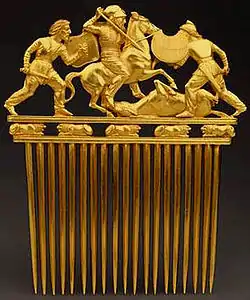
From 1925 to 1931, Dumézil was Professor of the History of Religions at Istanbul University.[1] During his years in Istanbul, Dumézil acquired proficiency in Armenian and Ossetian, and many non-Indo-European languages of the Caucasus. This enabled him to study the Nart saga, on which he published a number of influential monographs.[2] Dumézil developed a strong interest in the Ossetians and their mythology, which was to prove indispensable for his future research. For the rest of his life, Dumézil would make yearly visits to Istanbul to conduct field research among Ossetians in Turkey.[8] During this time he also published his Le problème des centaures (1929), which examined similarities in Greek and Indo-Iranian. It was inspired by Elard Hugo Meyer.[2] Together with Le festin d'immortalité (1924) and Le crime des Lemniennes (1924), Le problème des centaures would form part of the works Dumézil referred to as his "Ambrosia cycle".[8]
Dumézil's work in Istanbul would be of enormous importance to his future research, and he would later consider his years in Istanbul as the happiest of his life.[1][2] In 1930, Dumézil published his important La préhistoire indo-iranienne des castes. Drawing upon evidence from Avestan, Persian, Greek, Ossetian and Arabic sources, Dumézil suggested that ancient Indo-Iranians, including the Scythians, maintained a caste system which had been established before the Indo-Iranian migrations into South Asia. This article eventually caught the attention of French linguist Émile Benveniste, with whom Dumézil entered a fruitful correspondence.[8]
From 1931 to 1933, Dumézil taught French at Uppsala University. Here he became acquainted with the influential professor Henrik Samuel Nyberg and the latter's favourite students, Stig Wikander and Geo Widengren. Through Wikander and Widengren, Dumézil further became acquainted with Otto Höfler. Wikander, Widengren and Höfler would remain lifelong friends and intellectual collaborators of Dumézil. Throughout their careers, these scholars would have a strong influence on each other's research.[2] Most notably, Höflers research on the Germanic comitatus, and Wikander's subsequent research on related warrior fraternities among early Indo-Iranians, would have enormous influence on Dumézil's later research.[3][9]
Return to France
Dumézil returned to France in 1933, where he through the assistance of Sylvain Lévi, a friend of Meillet, was able to gain a position at the École pratique des hautes études (EPHE). From 1935 to 1968, Dumézil was Director of Studies at the Department of Comparative Religion at EPHE.[2] In this capacity he was responsible for teaching and research on Indo-European religions. Students of Dumézil during this time include Roger Caillois. At EPHE, through the recommendation of Lévi, Dumézil also attended lectures by sinologist Marcel Granet, whose methodology for the study of religions was to have a strong influence on Dumézil. Seeking to acquire knowledge of non-Indo-European cultures, Dumézil became proficient in Chinese and gained a deep understanding of Chinese mythology.[10]
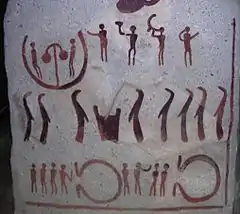
In his research on the social structure of ancient Indo-Iranians, Dumézil was greatly aided by Benveniste, who had earlier been critical of Dumézil's theories.[2] During his early years at EPHE, Dumézil modified many his theories. Most importantly, he increasingly shifted his focus from linguistic evidence to evidence from ancient social structures. Iranologists who influenced Dumézil in this approach include Arthur Christensen, James Darmesteter, Hermann Güntert and Herman Lommel.[2] Notable works of Dumézil from this period include Ouranos-Varuna (1934) and Flamen-Brahman (1935). Ouranos-Varuna examined similarities in Greek and Vedic mythology, while Flamen-Brahman examined the existence of a distinct priestly class among the Proto-Indo-Europeans.[11]
In the early 1930s, under the pseudonym "Georges Marcenay", he wrote some articles for the right-wing newspapers Candide and Le Jour, where he advocated an alliance between France and Italy against Nazi Germany.[12][13] Dumézil's opposition to Nazism figures prominently in several of his later works on Germanic religion.[14] At this time Dumézil joined the Grande Loge de France, a pro-Jewish masonic lodge, for which he would later be persecuted by the Nazis.[15][16]
Formulation of the trifunctional hypothesis
In the late 1930s, Dumézil broadened his research to include the study of Germanic religion.[2] His research on Germanic religion was greatly influenced by the renowned Dutch philologist Jan de Vries, and also by Höfler.[9] It was while lecturing on the Indo-European component in Germanic religion at Uppsala University in the spring of 1938 that Dumézil made a major discovery which was to revolutionize his future research.[17] In his subsequent Mythes et dieux des Germains (1939), Dumézil found that early Germanic society was characterized by the same social divisions as those among the early Indo-Iranians. On this basis, Dumézil formulated his trifunctional hypothesis, which argued that ancient Indo-European societies were characterized by a trifunctional hierarchy respectively composed of priests, warriors and commoners.[2]
In Dumézil's trifunctional model, the priests were responsible for the "maintenance of cosmic and juridical sovereignty", while warriors were tasked with the "exercise of physical prowess", and the commoners were responsible for "the promotion of physical well-being, fertility, wealth, and so on".[3] In Norse mythology, these functions were according to Dumézil represented by Týr and Odin, Thor, and Njörðr and Freyr, while in Vedic mythology, they were represented by Varuna and Mitra, Indra, and the Aśvins.[3] Dumézil's trifunctional hypothesis would come to revolutionize modern research on ancient civilizations.[4]
Career during World War II
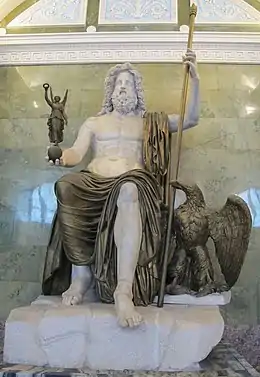
In the prelude to World War II, Dumézil returned to military service as a captain of the reserves in the French Army. He was subsequently posted at Liège as a liaison officer with the Belgian Army. Through the assistance of Maxime Weygand, a friend of his father, Dumézil was in April 1940 posted to the French military mission in Ankara, Turkey, where he remained during the Battle of France. He was repatriated to France in September 1940, and subsequently returned to full-time teaching at EPHE.[18] Because he had been a Freemason as a young man, Dumézil was fired from EPHE by the pro-Nazi Vichy government in early 1941. Through the influence of colleagues, he was however able to regain his position in the fall of 1943.[18]
During the war, Dumézil significantly reformulated his theories, and applied his trifunctional hypothesis to the study of Indo-Iranians, most notably in his work Mitra-Varuna (1940). In this work, Dumézil suggested that the Indo-Iranian gods Mitra and Varuna represented juridical and religious sovereignty respectively, and that these functions were relics of an earlier Indo-European tradition also manifested in Roman and Norse mythology.[19] In works such as Jupiter, Mars, Quirinus (1941), Horace et les Curiaces (1942), Servius et la Fortune (1943) and Naissance de Rome (1944), Dumézil applied his trifunctional hypothesis to the study of the Indo-European heritage of ancient Rome.[2]
Expanding the trifunctional hypothesis
From the late 1940s onwards, the comparative study of Vedic, Roman and Norse mythology and society would constitute the main focus of Dumézil's research. Iranian and Greek mythology played less conspicuous roles in his research. Naissance des archanges (1945) is his sole book on Iranian and Zoroastrian material. In this work, Dumézil suggests that the pantheon of the Mitanni was derived from an earlier pantheon shared by all Indo-Iranians, and that the main deities in the Indo-Iranian pantheon represented the three functions of Indo-European society. According to Dumézil, it was only during the rise of Zoroaster that Ahura Mazda became the chief deity in Iranian mythology.[2]
.jpg.webp)
In the years immediately after World War II, Dumézil recruited Claude Lévi-Strauss and Mircea Eliade to EPHE, and both became close friends whom he strongly influenced. These three men are widely considered the most influential mythographers of all time.[20] Notable works published by Dumézil in the late 1940s include Tarpeia (1947), Loki (1948), L'Héritage Indo-Européen à Rome (1949) and Le Troisième souverain (1949). The latter work examined the role of Aryaman and his Indo-European counterparts, such the Norse god Heimdallr, in wider Indo-European mythology.[18] Through several influential works of his friend Wikander, Dumézil came to doubt the universalist theories of Durkheim and Lévi-Strauss, and thus contended that the trinfuctional structure of Indo-European society was a distinct characteristic of the Indo-Europeans. Dumézil had studied the languages and mythology of several indigenous peoples of the Americas, and contended that trifunctionalism was not prevalent among those peoples.[21]
Dumézil was elected to the Collège de France in 1949, where he until 1968 was Chair of Indo-European Civilization.[1] This position was specifically created for him.[3] In the 1950s and 1960s, Dumézil's theories gained increasing acceptance among scholars. The spread of Dumézil's theories was greatly aided by support he received from friends such as Émile Benveniste, Stig Wikander, Otto Höfler and Jan de Vries.[22] Notable Iranologists who adopted Dumézil's theories include Benveniste, Wikander, Geo Widengren, Jacques Duchesne-Guillemin and Marijan Mole. Dumézil was however also criticized by certain Indologists, Iranologists and Romanists. Indologist Paul Thieme notably argued that the gods of the Mitanni were distinctly Indo-Aryan rather than Indo-Iranian, and that Dumézil's reconstruction of Indo-Iranian religion was thus mistaken. Dumézil responded vigorously to such criticism, while also continuously refining his theories. Most notably, Dumézil modified his theories on the trifunctional Indo-European social structure, which he now regarded more as an ideology than an established system.[2]
In 1955, Dumézil spent several months as a visiting professor at the University of Lima, during which he dedicated much time the study of the language and mythology of the Quechua people.[23] During the 1950s, Dumézil conducted much research on what he hypothesised to be a war between the various functions in Indo-European mythology, which he suggested culminated in the incorporation of the third function into the first and second function. Dumézil's ideas on this topic were published in Aspects de la fonction guerrière chez les Indo-Européens (1956). Other notable works published by Dumézil in the 1950s include Hadingus (1953), and several works on Roman, Celtic and Germanic religion.[24] His L'Idéologie tripartie des Indo-Européens, published in 1958, has been described as the best introductory work on Dumézil's core ideas.[3]
Retirement

Dumézil retired from teaching in 1968, but nevertheless continued a vigorous program of research and writing which continued until his death.[2] He would eventually become proficient in more than 40 languages, including all branches of the Indo-European languages, most languages of the Caucasus, and indigenous languages of the Americas (most notably Quechuan). Dumézil is credited with having saved the Ubykh language from extinction.[25] His magnum opus, Mythe et epopee, provides a thorough overview of the trifunctional ideology of Indo-European mythology, and was published in three volumes in (1968–1973).[26] In 1974, Dumézil would earn the Prix Paul Valery for this work.[2]
Dumézil research has been credited with being largely responsible for the revival of Indo-European studies and comparative mythology in the latter parth of the 20th century.[1] He was generally regarded as the world's foremost expert on the comparative study of Indo-European mythology.[27][28] From the late 1960s towards the end of his life, Dumézil's research came to be widely celebrated in the United States, where many of his works on Indo-European mythology were translated into English and published. Additional works inspired by Dumézil's theories were also published in the United States by scholars such as Jaan Puhvel, C. Scott Littleton, Donald J. Ward, Udo Strutynski and Dean A. Miller. Many of these scholars were associated with the University of California, Los Angeles (UCLA).[3]
Dumézil was made an Honorary Professor of the College de France in 1969, and became a Member of the Académie des Inscriptions et Belles-Lettres in 1970. Dumézil was a visiting professor at UCLA in 1971. He was elected to the highly prestigious Académie Française in 1975. His election to Académie Française was sponsored by Lévi-Strauss, who gave him the welcoming address.[29] Dumézil was also an Associate Member of the Royal Academy of Science, Letters and Fine Arts of Belgium, Corresponding Member of the Austrian Academy of Sciences, Honorary Member of the Royal Irish Academy, Honorary Fellow of the Royal Anthropological Institute of Great Britain and Ireland, and the recipient of honorary doctorates from the universities of Uppsala, Istanbul, Berne and Liège. He was an Officer of the Legion of Honor.[1]
In the 1970s and 1980s, Dumézil vigorously continued with research and publishing, and devoted himself particularly to the study of the Indo-European components in Ossetian and Scythian mythology. The much awaited third edition of his Mitra-Varuna was published in 1977.[29] He received the Prix mondial Cino Del Duca in 1984.
In his later years, Dumézil became a visible figure in French society, and was frequently interviewed and cited in the public press. His theories on Indo-European society were celebrated by Nouvelle Droite figures such as Alain de Benoist, Michel Poniatowski and Jean Haudry, but Dumézil was careful to distance himself from them. Dumézil openly identified with the political right, but always presented his works as apolitical, and had many friends and admirers on the left, such as Michel Foucault.[25]
Criticism of political affiliations
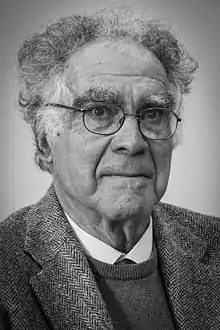
In the 1980–1990s, Dumézil came under heavy criticism from certain scholars, particularly left-wing historians,[32] who accused Dumézil of being a crypto-Fascist and a neo-traditionalist, by implicitly defending in his scholarly writings the restoration of a traditional hierarchical order in Europe (e.g. the three estates).[33] Many of these critics pointed out that Dumézil's lifelong close friend Pierre Gaxotte had been the secretary of Action Française leader Charles Maurras,[29] and that his work had been influential on members of the European New Right, including Alain de Benoist, Jean Haudry, or Roger Pearson, who used his theories to support far-right political positions, with an "Indo-European race" (conflated with white people) being seen as superior to all other peoples.[34] Bruce Lincoln has argued that Dumézil "maintained a cautiously ambiguous relation" with Nouvelle Droite figures like de Benoist and Haudry, "both of whom courted him avidly".[35]
During the 1930s, Dumézil supported the far-right, royalist, anti-democratic, and anti-German Action Française. While he held for a while Benito Mussolini in high regard,[36] he steadfastly opposed Nazism and voiced as a journalist his opposition to the growing danger posed by German nationalism.[13] However, Dumézil never joined Action Française, contending that "too many things separated [him] from them. The credo of the Action Française was a block: it forbade both appreciating Edmond Rostand and believing in the innocence of Captain Dreyfus."[6] Furthermore, Dumézil joined the Free Masonry in the early 1930s as a member of the Portique lodge of the Grande Loge de France of the Scottish Rite, and was consequently dismissed from his teaching positions and from the civil service by the collaborationist Vichy State during World War II.[15]
Some critics, particularly adherents of Lévi-Strauss, contended that the mythological and social structures Dumézil identified with Indo-Europeans were not distinctly Indo-European, but rather characteristic of all humanity. Among those were Colin Renfrew, who doubts that Indo-Europeans had anything distinctly in common beyond speaking Indo-European languages.[29] The harshest critics of Dumézil were Arnaldo Momigliano and Carlo Ginzburg, who charged Dumézil with having "sympathy for Nazi culture" due to his writings on Germanic religion in the 1930s.[37][38][39] They also accused Dumézil's trifunctional hypothesis of similarity with Fascism, and wrote that his reconstruction of Indo-European society was motivated by a desire to abolish "Judeo-Christian" values. Momigliano had himself been a member of the National Fascist Party in the 1930s, but was not open about this.[5][31]
Dumézil was also defended by many colleagues, including C. Scott Littleton, Jaan Puhvel, Edgar C. Polomé, Dean A. Miller, Udo Strutynski, and most notably by Didier Eribon.[2][5] Polomé and Miller saw the criticism of Dumézil as an expression of political correctness and Marxist ideology, and questioned the scholarly credentials of the critics.[16][40] Dumézil himself responded vigorously to these accusations, pointing out that he had never been a member of a Fascist organization, never been sympathetic to Fascist ideology, and that the ancient Indo-European hierarchical social structure never appealed to him.[41] In order to clarify his political position, he declared to Éribon in 1987: "the principle, not simply monarchical, but dynastic, which protects the highest office of the State from caprices and ambitions, seemed to me, and still seems to me, preferable to the generalized election in which we have been living since Danton and Bonaparte. The example of the [constitutional] monarchies of the North (of Europe) confirmed to me this feeling. Of course, the formula is not applicable in France."[6]
Death and legacy

Dumézil died in Paris from a massive stroke on 11 October 1986. He had deliberately refrained from writing a memoir, believing that the legacy of his work should stand on its scholarly merits alone.[29] However, shortly before his death, Dumézil made a series of in-depth interviews with his defender Eribon, which were subsequently published in Entretiens avec Georges Dumézil (1987). This book remains the closest Dumézil ever came to writing a memoir.[3] Upon his death, Dumézil left a number of unfishined works on Indo-European mythology, some of which were subsequently edited by his friends and published.[29]
Accusations of Fascist sympathies continued after Dumézil's death. Eribon's Faut-il brûler Dumézil? (1992) has been credited with permanently debunking accusations that Dumézil was a crypto-Fascist.[3] Charges of Fascist sympathies have nevertheless continued to be leveled, most notably by Eliade's former student Bruce Lincoln. Inspired by the critique of Momigliano and Ginzburg, Lincoln has criticized Dumézil from a Marxist perspective, and suggested that Dumézil was a Germanophobic Fascist.[32][42] Similar accusations have also been leveled by the Swedish Marxist historian Stefan Arvidsson, who hopes that the "exposure" of Dumézil's alleged political Fascist sympathies may lead to the abolishment ("Ragnarök") of the concept of Indo-European mythology .[43]
Throughout his career, Dumézil published more than seventy-five books and hundreds of scholarly articles.[3] His research continues to have a strong influence among Indo-Europeanists, classicists, Celticists, Germanicists, and Indologists.[2] Prominent scholars heavily influenced by Dumézil include Emile Benveniste, Stig Wikander, Jan de Vries, Gabriel Turville-Petre, Werner Betz, Edgar C. Polomé, Jaan Puvhvel, Joël Grisward, Nicholas Allen, Georges Charachidzé, François-Xavier Dillmann, Jacques Duchesne-Guillemin, Daniel Dubuisson, Lucien Gerschel, Emily Lyle, Dean A. Miller, Alwyn Rees, Brinley Rees, Robert Schilling, Bernard Sergent, Udo Strutynski, Donald J. Ward and Atsuhiko Yoshida.[29] Along with Marija Gimbutas, the research of Dumézil continues to form the basis for modern Indo-European studies.[44] His formulation of the trifunctional hypothesis has been described by C. Scott Littleton as one of the most important scholarly achievements of the 20th century.[29] Since 1995, the Académie Française awards the annual Prix Georges Dumézil for a work of philology.[45]
Personal life
Dumézil married Madeleine Legrand in 1925, with whom he had a son and a daughter.[1]
Selected works
- Le crime des Lemniennes: rites et legendes du monde egeen, Geuthner (Paris), 1924.
- Le festin d'immortalite: Etude de mythologie comparee indo-europenne, Volume 34, Annales du MuseeGuimet, Bibliothèque d'etudes, Geuthner (Paris), 1924.
- Le probleme des Centaures: Etude de mythologie comparee indo-europenne, Volume 41, Annales du MuseeGuimet, Bibliothèque d'etudes, Geuthner (Paris), 1929.
- Legendes sur les Nartes, Champion (Paris), 1930.
- La langue des Oubykhs, Champion (Paris), 1931.
- Etudes comparatives sur les langues caucasiennes du nord-ouest, Adrien-Maisonneuve (Paris), 1932.
- Introduction a la grammaire comparee des langues caucasiennes du nord, Champion (Paris), 1933.
- Recherches comparatives sur le verbe caucasien, 1933.
- Ouranos-Varuna: Etude de mythologie comparee indo-europenne, Adrien-Maisonneuve (Paris), 1934.
- Flamen-Brahman, Volume 51, Annales du Musée Guimet, Bibliothèque de vulgarisation, Geuthner (Paris), 1935.
- Contes lazes, Institut d'ethnologie (Paris), 1937.
- Mythes et dieux des Germains: Esai d'interpretation comparative, Leroux (Paris), 1939.
- Jupiter, Mars, Quirinus: Essai sur la conception indo-europennes de la societe et sur les origines de Rome, Gallimard (Paris), 1941.
- Horace et les Curiaces, Gallimard (Paris), 1942.
- Servius et la fortune, Gallimard (Paris), 1943.
- Naissance de Rome: Jupiter, Mars, Quirinus II, Gallimard (Paris), 1944.
- Naissance d'archanges, Jupiter, Mars, Quirinus III: Essai sur la formation de la theologie zoroastrienne, Gallimard (Paris), 1945.
- Tarpeia, Gallimard (Paris), 1947.
- Loki, G. P. Maisonneuve (Paris), 1948.
- Mitra-Varuna: Essai sur deux representations indo-europennes de la souverainete, Gallimard (Paris), 1948, translation by Derek Coltman published as Mitra-Varuna: An Essay on Two Indo-European Representations of Sovereignty, Zone Books (New York, NY), 1988.
- L'heritage indo-europenne a Rome, Gallimard (Paris), 1949.
- Le troiseme souverain: Essai sur le dieu indo-iranien Aryaman et sur la formation de l'histoire mythique d'Irlande, G. P. Maisonneuve, 1949.
- Les dieux des Indo-Europennes, Presses Universitaires de France (Paris), 1952.
- Rituels indo-europennes a Rome, Klincksieck (Paris), 1954.
- Aspects de la fonction guerriere chez les Indo-Europennes, Presses Universitaires de France (Paris), 1956.
- Deesses latines et mythes vediques, Collection Latomus (Brussels), 1956.
- (Editor and translator) Contes et legendes des Oubykhs, Institut d'ethnologie (Paris), 1957.
- L'ideologie tripartie des Indo-Europennes, Collection Latomus, 1958.
- Etudes oubykhs, A. Maisonneuve, 1959.
- Notes sur le parler d'un Armenien musulman de Hemsin, Palais des Academies (Brussels), 1964.
- (Editor and translator) Le livre des heros, Gallimard (Paris), 1965.
- Les dieux des Germains: Essai sur la formation de la religion scandinave, Presses Universitaires de France (Paris), 1959, translation published in Mythe et epopee, three volumes, Gallimard (Paris), 1968–73.
- Documents anatoliens sur les langues et les traditions du Caucase, A. Maisonneuve, 1960.
- La religion romaine archaique, Payot (Paris), 1966, translation by Philip Krapp published as Archaic Roman Religion, University of Chicago Press (Chicago, IL), 1970.
- The Destiny of the Warrior, translation by Alf Hiltebeitel, University of Chicago Press (Chicago, IL), 1970.
- Du myth au roman: La saga de Hadingus, Press universitaires de France (Paris), 1970, translation by Derek Coltman published as From Myth to Fiction: The Saga of Hadingus, University of Chicago Press (Chicago, IL), 1973.
- Heur et malheur de guerrier, second edition, Presses Universitaires de France (Paris), 1970.
- Gods of the Ancient Northmen, University of California Press (Berkeley), 1973.
- The Destiny of a King, translation by Alf Hiltebeitel, University of Chicago Press (Chicago, IL), 1974.
- Fetes romaines d'ete et d'automne suivi de Dix questions romaines, Gallimard (Paris), 1975.
- Les dieux souverains des indo-europennes, Gallimard (Paris), 1977.
- Romans de Scythie et d'alentour, Payot (Paris), 1978.
- Discours, Institut de France (Paris), 1979.
- Mariages indo-europennes, suivi de Quinze questions romaines, Payot (Paris), 1979.
- Camillus: A Study of Indo-European Religion as Roman History, translation by Annette Aronowicz and Josette Bryson, University of California Press (Berkeley), 1980.
- Pour un Temps, Pandora Editions (Paris), 1981.
- La courtisane et les seigneurs colores, et autres essais, Gallimard (Paris), 1983.
- The Stakes of the Warrior, University of California Press (Berkeley), 1983.
- L'Oubli de l'homme et l'honneur des dieux, Gallimard (Paris), 1986.
- The Plight of a Sorceror, University of California Press (Berkeley, CA), 1986.
- Apollon sonore et autres essais: vingt-cinq esquisses de mythologie, Gallimard (Paris), 1987.
- Entretiens avec Didier Eribon, Gallimard (Paris), 1987.
- Le Roman des jumeaux et autres essais: vingt-cinq esquisses de mythologie, Gallimard (Paris), 1994.
- Archaic Roman Religion: With an Appendix on the Religion of the Etruscans, Johns Hopkins University Press (Baltimore, MD), 1996.
- The Riddle of Nostradamus: A Critical Dialogue, translated by Betsy Wing, Johns Hopkins University Press (Baltimore, MD), 1999.
See also
- Hector Munro Chadwick
- John Colarusso
- Dennis Howard Green
- Winfred P. Lehmann
- J. P. Mallory
- Franz Rolf Schröder
- Calvert Watkins
- Martin Litchfield West
References
- Scott 2003.
- Lincoln 2010.
- Littleton 2005, pp. 2518–2520.
- The Times. 16 October 1986, p. 22.
- Littleton 1999, p. 566.
- Dumézil & Eribon 1987.
- Lincoln 1999, pp. 126–127.
- Littleton 1999, p. 559.
- Lincoln 1999, pp. 125–126. "No Germanist was more influential on Dumezil than Höfler, nor more closely associated with him throughout his career, except the Dutch historian of religions Jan de Vries... Also noteworthy is the Swedish Indo Europeanist Stig Wikander (1908–83), who remained a close friend and made fundamental contributions to Dumezil's thought over a period of five decades."
- Littleton 1999, p. 560.
- Littleton 1999, pp. 559–560.
- Lincoln 1999, p. 128.
- Eribon 1992, p. 124.
- Lincoln 1999, pp. 131–134.
- Eribon 1992, p. 249.
- Polomé 1999, pp. 248–251.
- Littleton 1999, pp. 560–561.
- Littleton 1999, p. 562.
- Littleton 1999, p. 561.
- Lincoln 1999, pp. 141–142.
- Littleton 1999, pp. 563–564.
- Lincoln 1999, pp. XIII–XIV.
- Littleton 1999, p. 564.
- Littleton 1999, p. 563.
- Lincoln 1999, p. 123.
- Littleton 1999, pp. 564–565.
- The Times. 16 October 1986, p. 22. "His authority in the field was supreme... it was generally recognized that the sphere of comparative Indo-European mythology virtually belonged to him."
- Lincoln 1999, p. 123. "Dumézil's [work] won him virtually universal admiration. [He was a] scholar of extraordinary abilities and erudition... Among his other gifts, he was master of countless languages: virtually all the Indo-European family, including some of its more obscure members (Armenian, Ossetic), as well as most of the Caucasian languages, one of which (Oubykh) he saved from extinction, and a few outliers like Quechua, which he seems to have acquired simply for fun. His oeuvre spanned six decades and includes more than fifty books, all of which are marked by extraordinary lucidity, ingenuity, rigor, and intelligence. His accomplishments have won wide acclaim among philologians, historians of religions, and anthropologists."
- Littleton 1999, p. 565.
- Lincoln 1999, p. 125.
- Arvidsson 2006, p. 2.
- Carlson 2008, p. 5. "Another issue is Bruce Lincoln’s overtly Marxist point of view. Marxism has traditionally criticized the neo-traditionalist and reactionary aspects of the Indo-European discourse and has been criticized by it in turn."
- Arvidsson 1999, p. 349; Arvidsson 2006, pp. 2, 241–3, 306
- Lincoln 1999, p. 137.
- Lincoln 1999, p. 123. "Dumézil was an entirely different sort of person from Pearson, Haudry, and de Benoist, infinitely more intelligent, decent, and much, much less crude. To the best of my knowledge, he had no dealings with Pearson, and over the years he maintained a cautiously ambiguous relation with the two others, both of whom courted him avidly."
- Arvidsson 2006, p. 3.
- Momigliano 1984, pp. 312–330; Momigliano 1994, pp. 286–301
- Ginzburg 1989, pp. 114–131.
- Lincoln 1999, p. 124; Scott 2003
- Miller 2000, pp. 27–40.
- Dumézil 1985, pp. 985–989; Dumézil & Eribon 1987, p. 162. "Je n'aurais pas du tout aimé vivre chez aucun de ceux que j'ai étudiés. Je n'aurais pu respirer dans une société dominée par des druides, ou par des brahmanes."; Dumézil 2006
- Lincoln 1991, pp. 231–243; Lincoln 1999, pp. 121–137; Lincoln 2010; Arvidsson 2006, p. 2
- Arvidsson 2006, pp. 2–3; Arvidsson 1999, pp. 353–354; Carlson 2008, p. 8
- Arvidsson 2006, p. 315.
- academie-francaise.fr.
Sources
- Académie Française. "Prix Georges Dumézil". academie-francaise.fr (in French). Retrieved 6 October 2020.
- Arvidsson, Stefan (June 1999). "Aryan Mythology As Science and Ideology". Journal of the American Academy of Religion. Oxford University Press. 67 (2): 327–354. doi:10.1093/jaarel/67.2.327. JSTOR 1465740. Retrieved 8 September 2020.
- Arvidsson, Stefan (2006). Aryan Idols: Indo-European Mythology as Ideology and Science. University of Chicago Press. ISBN 0226028607.
- Carlson, Maria (2008). "A Detailed Look at Stefan Arvidsson's Aryan Idols". Slavic Cultural Studies. University of Kansas. Retrieved 13 September 2020.
- Dumézil, Georges (1985). "Science et politique. Réponse à Carlo Ginzburg". Annales. Histoire, Sciences Sociales (in French). School for Advanced Studies in the Social Sciences. 40 (5): 985–989. doi:10.3406/ahess.1985.283216. JSTOR 27583135. S2CID 162317036. Retrieved 17 September 2020.
- Dumézil, Georges; Eribon, Didier (1987). Entretiens avec Didier Eribon (in French). Gallimard. ISBN 2070323986.
- Dumézil, Georges (2006). "Une idylle de vingt ans (A. Momigliano, OPVS, II, 2 pp. 329–341)". L'oubli de l'homme et l'honneur des dieux et autres essais (in French). Gallimard. ISBN 2070703169.
- Eribon, Didier (1992). Faut-il brûler Dumézil? (in French). Flammarion. ISBN 2080667092.
- Ginzburg, Carlo (1989). "Germanic Mythology and Nazism: Thoughts on an Old Book by Georges Dumézil". Clues, Myths, and the Historical Method. Johns Hopkins University Press. pp. 114–131. ISBN 1-4214-0991-7.
- Lincoln, Bruce (1991). "Shaping the Past and the Future". Death, War, and Sacrifice: Studies in Ideology & Practice. University of Chicago Press. pp. 231–243. ISBN 0-226-48199-9.
- Lincoln, Bruce (1999). Theorizing Myth: Narrative, Ideology, and Scholarship. University of Chicago Press. ISBN 0226482022.
- Lincoln, Bruce (15 March 2010). "DUMÉZIL, Georges". Encyclopædia Iranica. Retrieved 16 September 2020.
- Littleton, C. Scott (2005). "DUMÈZIL, GEORGES". In Jones, Lindsay (ed.). Encyclopedia of Religion. Vol. 4 (2 ed.). Macmillan Reference USA. pp. 2518–2520. ISBN 0-02-865737-3.
- Littleton, C. Scott (1999). "Gods, Myths And Structures: Dumézil". In Glendinning, Simon (ed.). The Edinburgh Encyclopedia of Continental Philosophy. Psychology Press. pp. 558–568. ISBN 1579581528.
- Miller, Dean A. (2000). "Georges Dumézil: Theories, Critiques and Theoretical Extensions". Religion. Routledge. 30: 27–40. doi:10.1006/reli.1999.0239. S2CID 171034204. Retrieved 17 September 2020.
- Momigliano, Arnoldo (October 1984). "Georges Dumézil and the Trifunctional Approach to Roman Civilization". History and Theory. Wiley-Blackwell. 23 (3): 312–330. doi:10.2307/2505078. JSTOR 2505078. Retrieved 17 September 2020.
- Momigliano, Arnoldo (1994). "Introduction to a Discussion to Georges Dumézil". Studies on Modern Scholarship. University of California Press. pp. 286–301. ISBN 0-520-07001-1.
- Polomé, Edgar C. (1999). "About Dumézil". Journal of Indo-European Studies. 27 (1): 248–251. ProQuest 206808390.
- Scott, Paula Pyzik (5 November 2003). "Georges (Edmond Raoul) Dumezil". Contemporary Authors. Gale. Retrieved 16 September 2020.
- "M George Dumézil". The Times. 16 October 1986. p. 22 – via Gale.
Further reading
- Allen, Nicholas (1987). "The ideology of the Indo-Europeans: Dumézil's theory and the idea of a fourth function". International Journal of Moral and Social Studies. 2 (1): 23–39.
- Allen, Nicholas (1999). "Hinduism, structuralism and Dumézil" (PDF). In Polomé, Edgar C. (ed.). Miscellanea Indo-Europea. Journal of Indo-European Studies Monograph Series. Vol. 33. Institute for the Study of Man. pp. 241–260. ISBN 0941694712. ISSN 0895-7258.
- Belier, Wouter W. (1991). Decayed Gods: Origin and Development of Georges Dumézil's Idéologie Tripartie. BRILL. ISBN 9004301518.
- Burgess, Patricia, ed. (1986). "Georges Dumézil". Annual Obituary. Vol. 86. St. James Press. pp. 575–576. ISBN 1558620133.
- Coutau-Bégarie, Hervé (1998). L'œuvre de Georges Dumézil: Catalogue Raisonné. Economica. ISBN 2717835482.
- Dubuiosson, Daniel (2006). Twentieth Century Mythologies: Dumézil, Lévi-Strauss, Eliade (2 ed.). Equinox Publishing. ISBN 1845530217.
- Fussman, Gerard (1987). "Hommage à Georges Dumézil". Collège de France. Retrieved 16 September 2020.
- Haugen, Einar (1956). The Mythical Structure of the Ancient Scandinavians: Some Thoughts on Reading Dumézil.
- Littleton, C. Scott (1982). The New Comparative Mythology: An Anthropological Assessment of the Theories of Georges Dumézil (3 ed.). University of California Press. ISBN 0520041038.
- Segal, Robert Allan, ed. (2006). Structuralism in Myth: Lévi-Strauss, Barthes, Dumézil, and Propp. Taylor & Francis. ISBN 0815322607.
- Polomé, Edgar C., ed. (1996). Indo-European Religion After Dumézil. Journal of Indo-European Studies Monograph Series. Vol. 16. Institute for the Study of Man. ISBN 0941694518. ISSN 0895-7258.
- Strutynski, Udo (1975). George Dumézil and the Study of the Indo-European Component in Germanic Mythology. University of California, Los Angeles. ISBN 9780942299120. OCLC 320183328.
External links
- Overview of Dumézil's career (in French)
- Academie Française biography of Dumézil (in French)